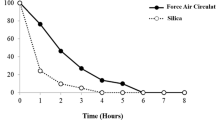Abstract.
Young Carex extensa Good., C. remota L. and C. pseudocyperus L. plants were subjected to aerobic or anaerobic growth conditions in nutrient solution for 40 d. Root anatomy was studied by serial transsections and longitudinal sections of the root tip. Under both growth conditions, the flooding-intolerant C. extensa developed the typical Carex root pattern, i.e. an intact cortex in the youngest part of the root, but lysogenous aerenchyma in maturing parts. In contrast, flooding-tolerant C. remota from periodically flooded habitats showed a similar root anatomy to C. extensa under aerobic conditions, but a cortex with fine intercellular spaces throughout most of the root under anaerobic conditions. The flooding-tolerant C. pseudocyperus from permanently flooded stands developed an intact cortex over most of the root length under both growth conditions. Fine intercellular spaces on four sides of each cortical cell penetrated into the very tip of the root in this species, connecting the whole root with the lacunae of the leaves and the atmosphere. In both flooding-tolerant species, morphometry showed that even under anaerobic growth conditions and despite the maintenance of a juvenile growth habit, i.e. intact cortical cells, the average root porosities were more than 20% and there was an increase in the contact area between intercellular gas spaces and the surface of cortical cells. While C. remota showed radial oxygen loss along the whole root length, C. pseudocyperus released oxygen to an oxygen-free medium only at the root tip. It is concluded that the maintenance of a juvenile root structure in combination with a system of fine intercellular spaces allows efficient nutrient uptake and plant growth during anaerobiosis in flooding-tolerant Carex species, in contrast to those species which may tolerate periods of anaerobiosis by forming aerenchyma at the cost of decreased nutrient uptake and growth.
Similar content being viewed by others
Author information
Authors and Affiliations
Additional information
Received: 10th February 1998 / Accepted: 2nd July 1998
Rights and permissions
About this article
Cite this article
Moog, P. Flooding tolerance of Carex species. I. Root structure. Planta 207, 189–198 (1998). https://doi.org/10.1007/s004250050472
Issue Date:
DOI: https://doi.org/10.1007/s004250050472




